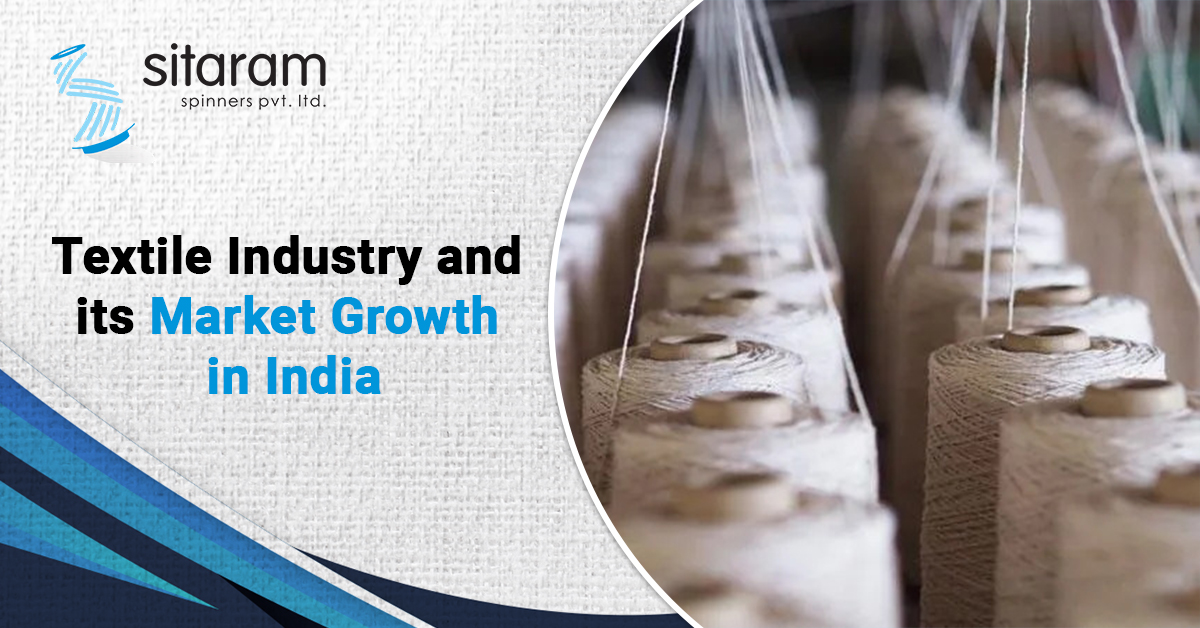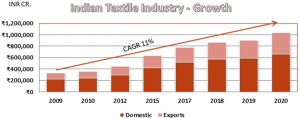- Date: Dec 07,2022
- Posted By: admin
- Views: 494
Textile Industry and Its Market Growth in India | Sitaram Spinners

Textile Industry and Its Market Growth in India:-
With a sizable base of raw materials and textile manufacturing, India is one of the largest textile industries worldwide. One of India’s oldest businesses, Textile Industry have a significant impact on the country’s economy as it accounts for one-third of our gross export revenues, 14% of manufacturing value-added, and millions of people with gainful employment. One of the earliest industries in India, it contributes to over 30% of all exports, amounts to 14% of total industrial production, and is the second largest employer after agriculture.
Growth of the Indian Textile Industry:-
India’s textile sector is significant on a global scale, coming in fifth place for the production of synthetic fibers and yarns and second to China for the production of cotton fabric and yarn. The Indian textile and apparel industry is expected to grow at 10% CAGR from 2019-20 to reach US$ 190 billion by 2025-26. India has a 4% share of the global trade in textiles and apparel. India is the world’s largest producer of cotton. Estimated production stood at 362.18 lakh bales during cotton season 2021-22. India’s textile and apparel exports (including handicrafts) stood at US$ 44.4 billion in FY22, a 41% increase YoY. Exports of readymade garments including cotton accessories stood at US$ 6.19 billion in FY22. The industry (including dyed and printed) attracted foreign direct investment (FDI) worth US$ 3.99 billion from April 2000-March 2022. The textiles sector has witnessed a spurt in investment during the last five years.

Advantage – India:-
In contrast to other major textile-producing nations, India’s textile industry is characterized by a large number of small-scale, non-integrated spinning, weaving, cloth finishing, and garment businesses that frequently employ outmoded technologies. Some businesses—usually larger ones—operate in the “organized” sector, where they are subject to several labor and tax restrictions. However, the majority of businesses operate in the small-scale “unorganized” sector, where laws are easier to break and less onerous to comply with. Technical efficiency and global competitiveness have significantly increased as a result of policy reforms that started in the 1980s and extended into the 1990s, especially in the spinning industry. India offers several benefits in the textile industry, including easy access to labor and raw materials. In terms of global cotton commerce, it ranks second. It is the third largest producer of cotton fiber in the world and has the largest cotton acreage, which is over nine million hectares. It comes in fourth place for both the production of polyester yarn and staple fiber. Because the textile business requires a lot of labor, India enjoys an advantage.
Boosting Indian Economy:-
The textile sector is very important to the economy. In terms of output, foreign exchange profits, and employment in India, the textile industry is one of the biggest and most significant economic sectors. It produces 20% of industrial production, 9% of excise revenue, 18% of industrial sector employment, over 20% of the nation’s total export earnings, and 4% of GDP. The industry is the second largest employer in the nation, with approximately 35 million workers. The performance of important fiber crops and crafts, including cotton, wool, silk, handicrafts, and handlooms, which employ millions of farmers and artisans in rural and semi-urban areas, is directly correlated with the textile industry. According to estimates, this industry affects one in every six households in the nation either directly or indirectly.
Contribution of Sitaram Spinners in Indian Textile Industry:-
Sitaram Spinners Private Limited (SSPL), being a high-quality core spun yarn producer, a well-known name in the science and art of yarn production industry in India, has been contributing to the Indian Textile Industry since it’s commencement of journey. Intending to become a preferred provider of premium quality yarn, Sitaram Spinners engages in the art of yarn production using cutting-edge technology and is supported by a team of industry experts. Since Sitaram Spinners has been in the yarn manufacturing business from the year 2008, it is directly and indirectly providing employment to 2500 families. The company has been perfecting its abilities to become the ideal yarn craftsman, which has helped to carve a reputation in the creation of Quality yarn.
The Bright Future:-
The future of the Indian textiles industry looks promising, buoyed by strong domestic consumption as well as export demand. India is working on various major initiatives to boost its technical textile industry. Owing to the pandemic, the demand for technical textiles in the form of PPE suits and equipment is on the rise. The government is supporting the sector through funding and machinery sponsoring. Top players in the sector are achieving sustainability in their products by manufacturing textiles that use natural recyclable materials. With consumerism and disposable income on the rise, the retail sector has experienced a rapid growth in the past decade with the entry of several international players like Marks & Spencer, Guess and Next into the Indian market. The growth in textiles will be driven by growing household income, increasing population and increasing demand by sectors like housing, hospitality, healthcare, etc.


